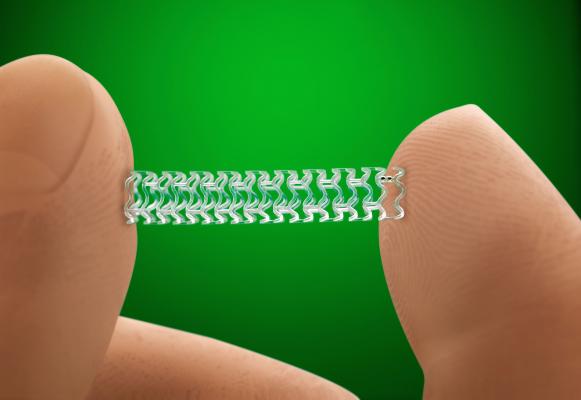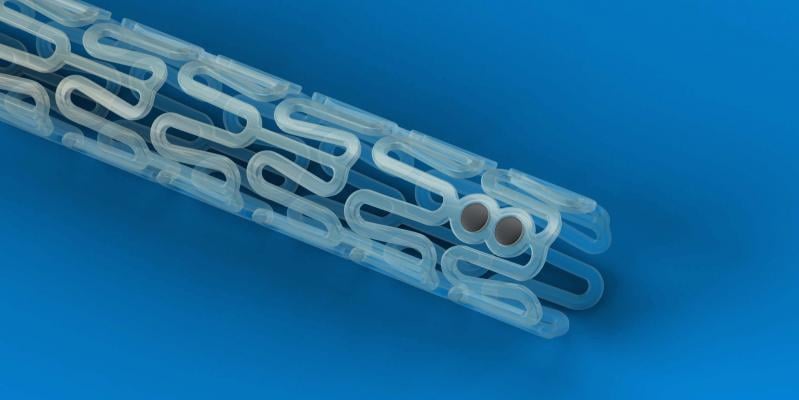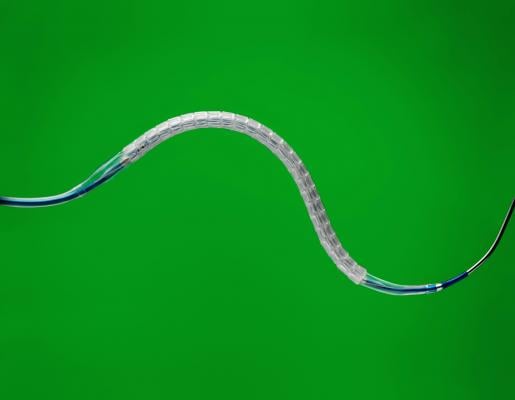
Bioresorbable stents have been one of the hottest new cardiovascular technologies discussed at cardiology meetings over the past several years, and the first device is now pending final U.S. Food and Drug Administration (FDA) review. In March, an independent panel of experts convened by the FDA voted 9 to 0, with one abstention, that the benefits of Abbott's Absorb fully bioresorbable drug-eluting coronary stent outweigh the risks. A final decision on market approval is likely to come later in 2016.
Absorb is a first-of-its-kind, fully bioresorbable stent for the treatment of coronary artery disease. While most stents are made of metal, the Absorb is made of dissolvable polylactic acid (PLA) plastic. It dissolves completely after two to three years, once it has done its job of keeping a clogged artery open and promoting healing of the artery. By contrast, metal stents are permanent implants that restrict vessel motion by caging the artery for the life of the patient.
While these are all seen as positive features of the technology, no clinical evidence exists showing that it makes any difference in real-world outcomes, said Daniel Simon, M.D., division chief, cardiovascular medicine, UH Case Medical Center, president of the UH Case Medical Center, and a co-investigator in the Absorb trials. He said the FDA panel took a sort of limited, non-inferiority approach to the device in regard to target lesion failure, but he said there are many questions that remain about bioresorbable stents that will need to be answered before they become a workhorse device, replacing metallic drug-eluting stents (DES).
“The question we should be asking is what the clinical performance of the device is and how will it be used by physicians in clinical practice,” Simon said. “No one knows what the clinical benefit of a bioresorbable stent is. They do return the vessel to a normal state of vasomotion without caging the vessel, but there is no clinical data yet showing this actually helps patients’ long-term outcomes.”
This clinical question, combined with the device’s delivery issues and its high cost, have restricted its use in Europe. “In Europe, the Absorb is a niche device and it is not being used as a workhorse stent,” he said, explaining it is likely the stent will find similar limited, niche use in the United States once approved.
A Paradigm Shift or Hype?
Many cardiology experts see bioresorbable scaffolds as the next step in the evolution of stent technology. Many believe they may offer a change in the standard of care, replacing metallic DES. However, there are barriers to this happening.
“We are very hopeful this technology will help improve long-term outcomes compared to metallic drug eluting stents, that’s why these were developed,” explained Gregg W. Stone, M.D., FACC, FSCAI, director, cardiovascular research and education, Center for Interventional Vascular Therapy, Columbia University Medical Center, New York-Presbyterian Hospital and the chairman of the Absorb clinical trial program. “Having a fixed metal frame in the artery really limits the long term outcomes and serves as an ongoing nidus for inflammation, for strut fracture, vessel straightening, compliance mismatch and tissue growth inside the stents. You can get rid of all of that with a scaffold that disappears, but it may take five years, maybe even longer before we see the different event rates. In multiple randomized clinical trials, the Absorb bioresorbable vascular scaffold has demonstrated comparable outcomes to the leading permanent metallic stent. As a first-in-kind device with novel properties, including complete dissolution and natural restoration of vessel function, this is a remarkable achievement.”
While Simon agrees the device is a major step forward in stent technology, he said the technology needs to overcome several issues. To start, the device costs more than a metallic stent and it is more difficult to navigate and deploy because its struts are thicker than the current metallic DES. He said it also requires more imaging than metallic stents, adding procedure time and exposing the patient to more X-ray dose. Accurate vessel sizing is also more critical than metallic stents, because overexpansion causes stent fractures much more easily. More lesion preparation is usually required with the Absorb and procedures usually require more disposables than metallic stenting. The bioresorbable devices also require more dual-antiplatelet therapy and for a longer period of time due to higher stent thrombosis rates, Simon explained.
“We know this will not be a workhorse stent — just look at its usage in Europe,” Simon said. “But, it is a stepping stone technology. Interventional cardiology is a field that is filled with technological innovation. Everybody wants to get their hands on the Absorb stent and use it, but they will run into issues such as it not being easy to deliver and find it has high rates of thrombosis. I’m all for technological innovation and this is a step forward, but we need more clinical data to validate the technology.”
Poor Performance in Small Vessels
Stone said the first generation device does have limits, particularly in small vessels of 2.5 mm or smaller, where it had higher rates of in-stent thrombosis in the pivotal Absorb III trial. That trial showed safety and efficacy non-inferiority for the Absorb compared to the Xience V stent. But, data analysis found a sub-group of patients with vessels smaller than 2.5 mm that were stented where there was a cause for concern. Stone presented this sub-group analysis at the 2016 American College of Cardiology (ACC) meeting in April.
Video interview with Stone explaining the poor Absorb outcomes in small vessels at ACC.16
“There were some slight trends toward worse adverse event outcomes with the Absorb scaffold,” Stone said. “We saw non-significant trends in scaffold thrombosis and increased target vessel myocardial infarction. So, we did a detailed analysis of these events to see where they might be coming from. One of the big differences between devices and metallic drug eluting stents is that they are thicker, so we suspected that in smaller vessels the struts would occupy more space, which could lead to blood turbulence and increased platelet deposition. It turned out about 19 percent of patients had this device used in vessels smaller than 2.5 mm, the smallest size the Absorb was intended for. And, sure enough, those where the vessels where the scaffold thrombosis and target lesion MI events tended to cluster, whereas the other 80 percent of patients who had the right sized vessels for Absorb, the outcome rates were very similar between Xience and Absorb.”
This data was shown to the FDA panel in March and will likely play a role in labeling restrictions on the use of the stent in small vessels. “We recommended to the FDA that there is a need for rigorous training so we can help physicians avoid treating these very small vessels,” Stone explained. He said the Absorb labeling will likely have some sort of warning about using the stent in small vessels and that some sort of quantitative imaging should be used to properly size the vessels.
Delivery Issues
The Absorb has 157 micron strut thickness, which is comparable to the first-generation Cypher DES from more than a decade ago. Like the Cypher, Simon said Absorb’s larger profile causes delivery issues in smaller, tortuous vessels, adding time to procedures. “The most important thing is delivery of the stents — operators want shorter procedures,” Simon said.
A reduction in the stent strut thickness to profiles closer to current-generation metallic stents should make the stent easier to use and deliver, Simon said. However, longer stent sizes are needed and there are still questions of how to build a bioresorbable stent that does not require additional lesion prep, he explained.
Stone said a new, thinner Absorb stent of less than 100 microns will enter trials later this year, which he said will be much closer to the 91 micron thickness of a Xience stent.
Potential Advantages
Despite the faults of this first generation technology, Simon said the future for these devices might be very bright if it can show superior outcomes data over today’s metallic DES. Simon said there are possible advantages, such as the return of vasomotion, enabling future coronary artery bypass graft (CABG) surgery because no permanent hardware is left behind. Data also suggests these devices might reduce the incidence of angina.
Simon said the stent may be ideal for mid-left anterior descending (LAD) coronaries that are typically the site for CABG bypass grafts. The current use of metallic stents prohibits future CABG options.
However, it will be the long-term target lesion revascularization rates that will be a key indicator of the future of the device. Trials will have to be run to gather data in all these areas to justify the higher cost and drawbacks of the current device, Simon explained.
“This is science and you have to show not only equivalence, you have to show your device has clinical advantages,” he said. “In science, disappearing is not enough, you need to show clear clinical evidence that it is better than what you are currently using.”
Future of Bioresorbable Stents
To address some of the unanswered questions regarding bioresorbable stents, the Absorb IV Trial will begin recruiting patients in 2016. This large, randomized trial will include 5,000 patients and is powered to show late superiority of Absorb compared to Xience. Stone said the earliest results might be presented in 2020. He also said another trial is gearing up to test the Absorb in ST-elevated myocardial infarction (STEMI) patients, which he said might be a sweet spot niche for bioresorbable stents.
“If those trials are positive, then I think bioresorbable technology will ultimately be used in the majority of patients,” Stone said.
Competing Technologies
Other stent technologies in development will compete with bioresorbable devices. These include new metal stents that eliminate the need for polymers to carry the anti-proliferative drug coatings. Simon said Medtronic’s drug-filled metallic stent that elutes the drug through microscopic holes, BioSensors BioFreedom, is a polymer-free DES, and Boston Scientific’s Synergy stent uses a bioresorbable polymer on a metallic stent. Simon noted all three of these stents are designed as workhorse devices. He also noted Synergy already sees much wider use in Europe than the Absorb, because it offers many of the benefits of both metallic and drug-eluting stents.




 July 31, 2024
July 31, 2024 









